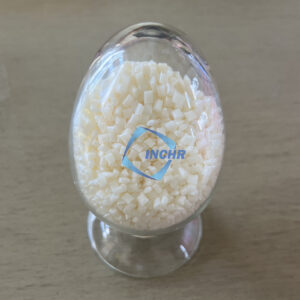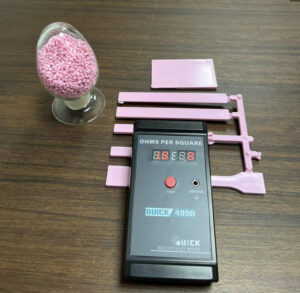ABS antistatic compound 53AS is a special material formed by adding permanent antistatic additive PA550AN to ABS resin, mainly used to eliminate or reduce the generation and accumulation of static electricity for ESD protection.
Components of antistatic compound 53AS
- ABS resin matrix: ABS (acrylonitrile-butadiene-styrene) is a thermoplastic polymer with good toughness, heat resistance, and impact resistance, which provides basic physical properties and processing properties for antistatic compounds.
- Permanent antistatic agent: This is a key component that can improve the conductivity of the material, and enable static electricity to be quickly conducted or leaked, thereby reducing surface resistance and reducing the generation of static electricity. PA550AN is a polyether block amide copolymer with permanent antistatic properties. It differs from the common cationic, anionic, nonionic, and other types.

Manufacturing method of antistatic compound 53AS
- Direct dry mixing addition method: Mix the permanent antistatic masterbatch directly with ABS resin. First, determine the appropriate addition amount. Generally, the addition ratio in ABS resin is about 5% – 12%, which must be determined according to the antistatic effect requirements and processing technology. Then use a mixer and other equipment to fully mix the two, and then carry out subsequent processing and molding, such as injection molding, extrusion, etc.
- Compounding method: First, a high-concentration permanent antistatic agent is compounded and granulated with ABS resin and other additives through an extruder and other equipment to make an antistatic compound. During the compounding process, 1%-3% of a compatibilizer is strongly recommended to be added. The ABS antistatic compound produced in this way will have better mechanical properties, a more stable antistatic effect, and the same resistivity at any position of the terminal product.
Performance characteristics of antistatic compound 53AS
- Antistatic performance: It can effectively reduce the surface resistance of the material so that static electricity can be quickly dissipated and prevent the accumulation and discharge of static electricity. The surface resistance can generally reach 10⁶ – 10⁹Ω, which meets the requirements of most antistatic applications.
- Long-lasting antistatic effect: Compared with some temporary antistatic treatment methods, the antistatic effect of ABS antistatic compound has better durability and will not quickly lose antistatic properties due to the passage of time or changes in the use environment.
- Customizable color: Since permanent antistatic additive PA550AN is used instead of conductive fillers such as carbon black, it can be customized according to customer needs to produce products of various colors to meet the appearance design requirements of different products.
- Good electrical insulation performance: Although the antistatic compound has antistatic properties, it can still maintain good electrical insulation, which can meet some application scenarios that require electrical insulation performance, such as the housing and insulating parts of electronic and electrical equipment.
- Mechanical properties: After adding an antistatic additive, ABS antistatic compound can still maintain good mechanical properties, such as strength, toughness, and wear resistance, which are comparable to ordinary ABS compounds.
- Processing performance: Since most of the components in the antistatic compound are ABS resin matrix, it is well known that ABS resin has good fluidity, so the antistatic compound has good processing performance and can be processed by conventional plastic processing methods, such as injection molding, extrusion, etc.

Application fields of antistatic compound 53AS
- Electronic and electrical industry: used to manufacture electronic equipment housings, display housings, keyboards, mice, etc., to prevent dust adsorption caused by static electricity and damage to the components of electronic products.
- Automobile industry: The antistatic compound can be applied to injection molding parts such as automotive interiors, dashboards, bumpers, etc., to reduce the risk of static electricity and improve the safety and comfort of automobile use.
- Medical device field: used to manufacture medical equipment housings, surgical instruments, etc., to reduce the interference of static electricity on the operation of medical equipment.
- Other fields: can also be used in related fields such as aerospace, chemical industry, petroleum, etc., for special occasions where there are safety hazards of static electricity discharge.




